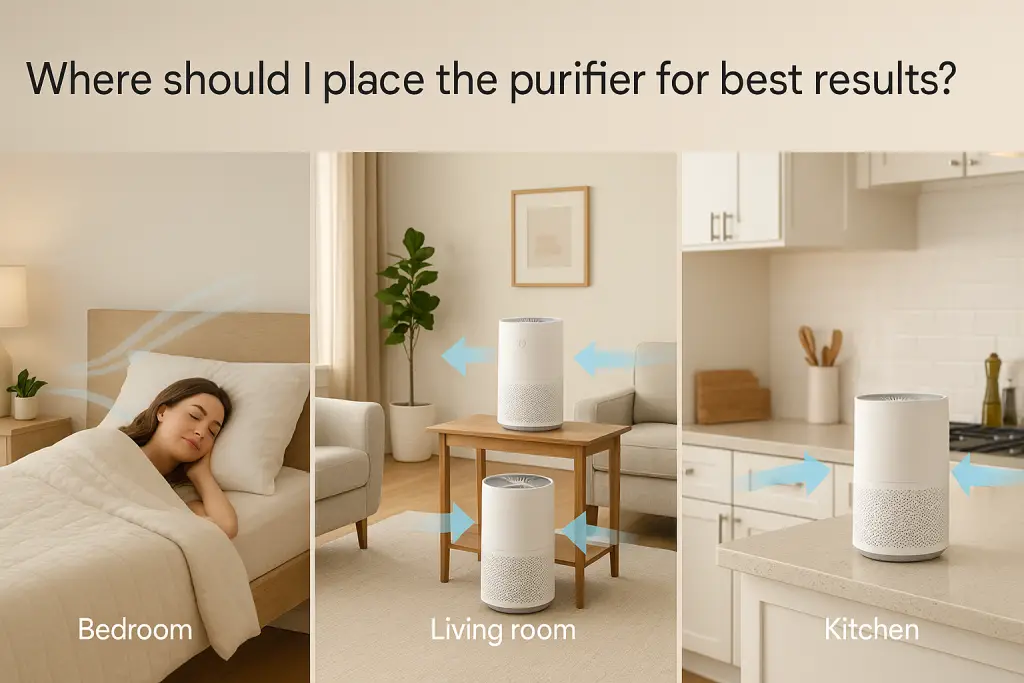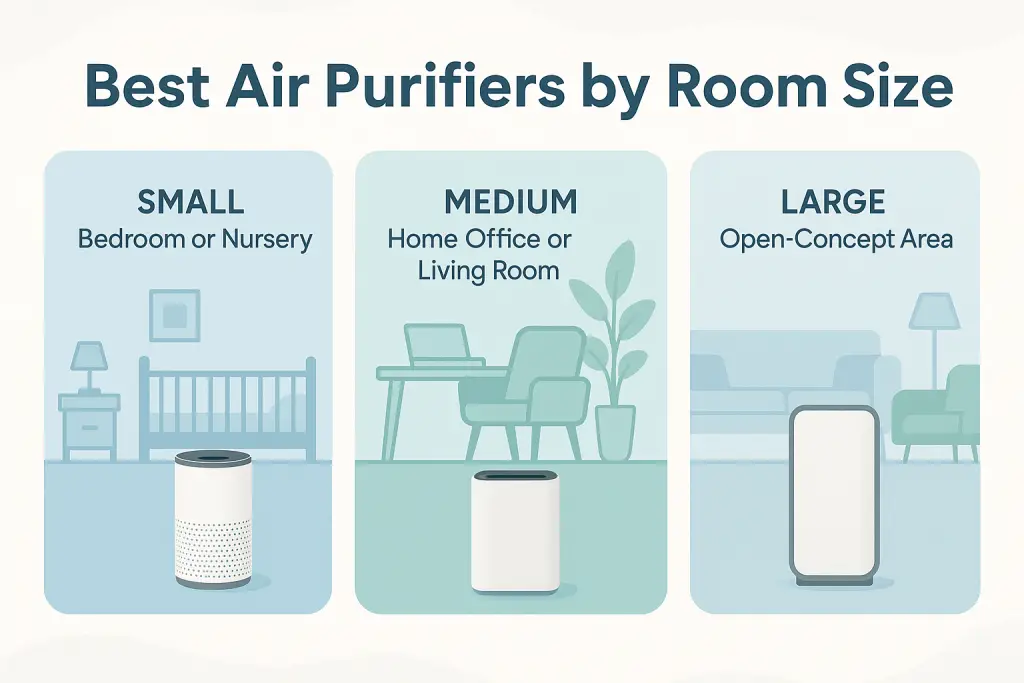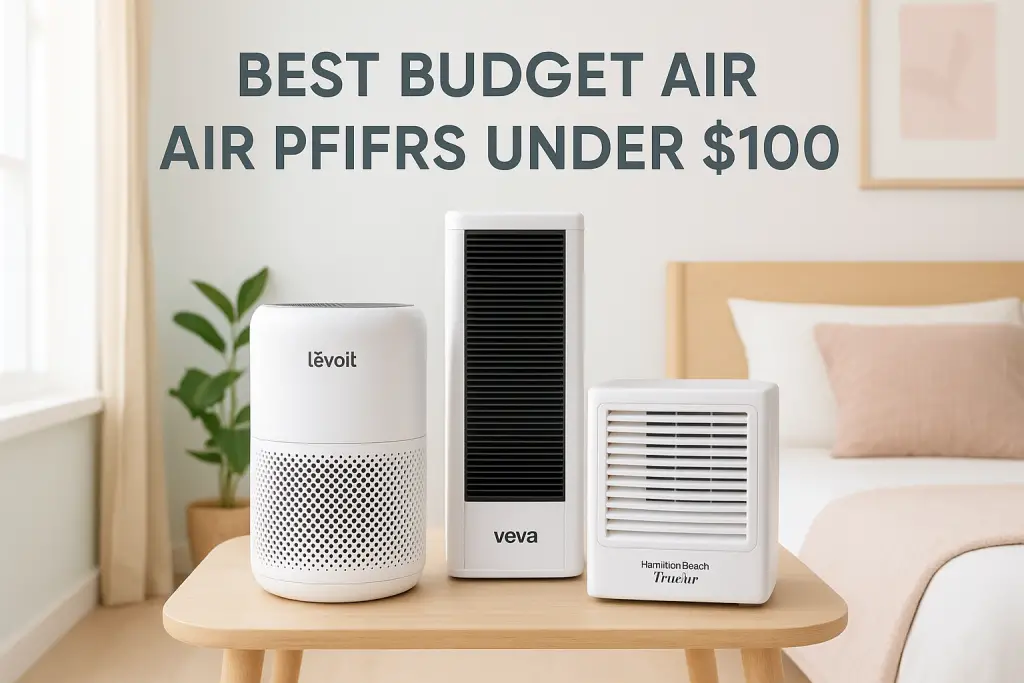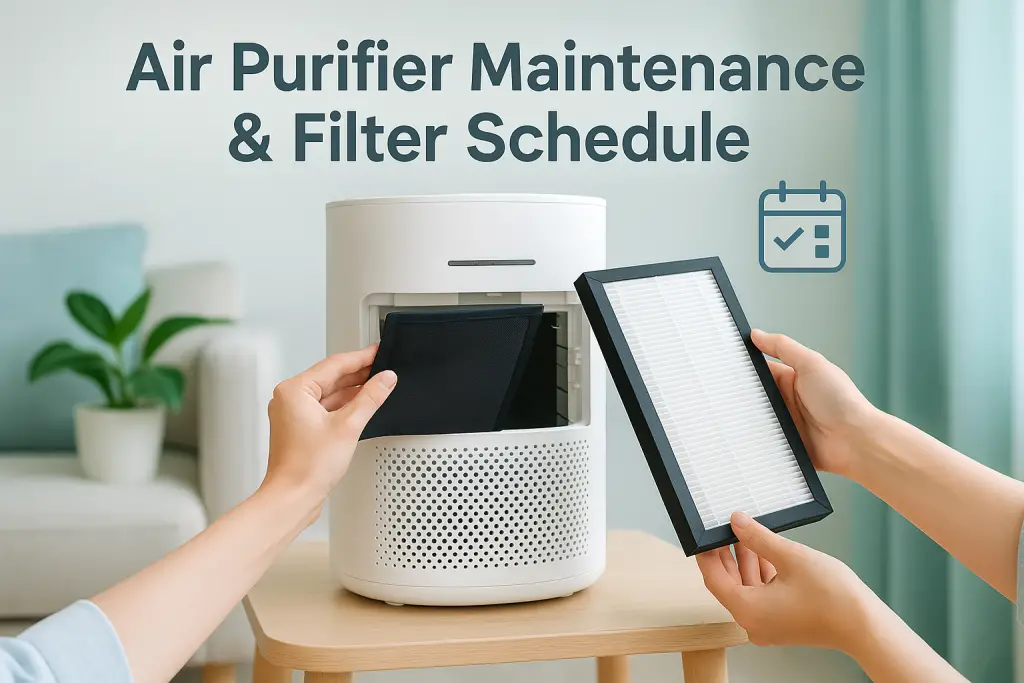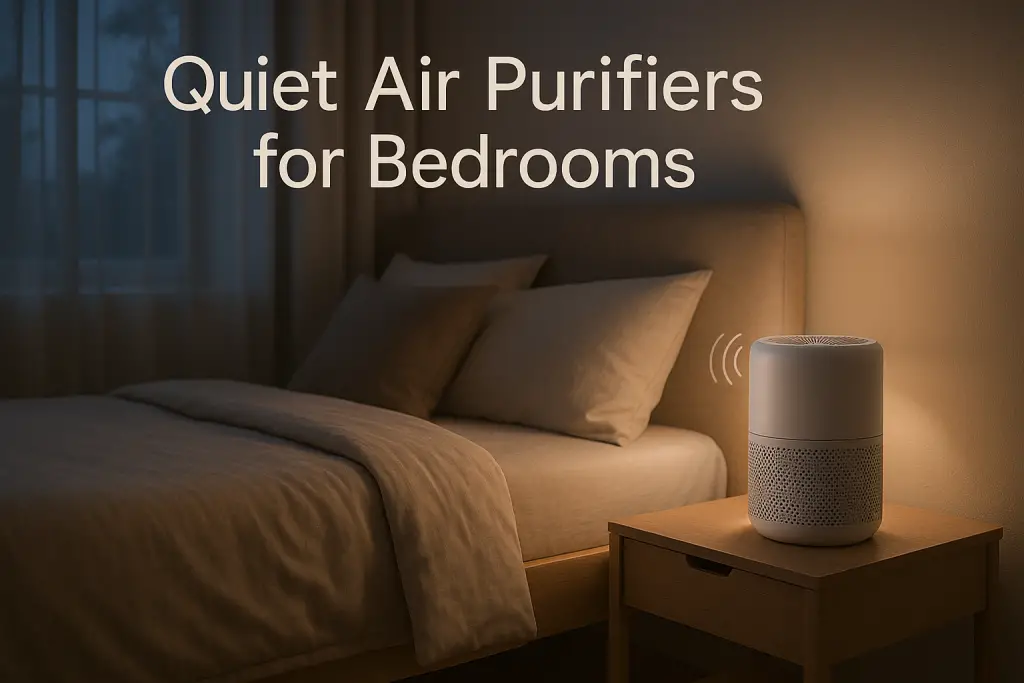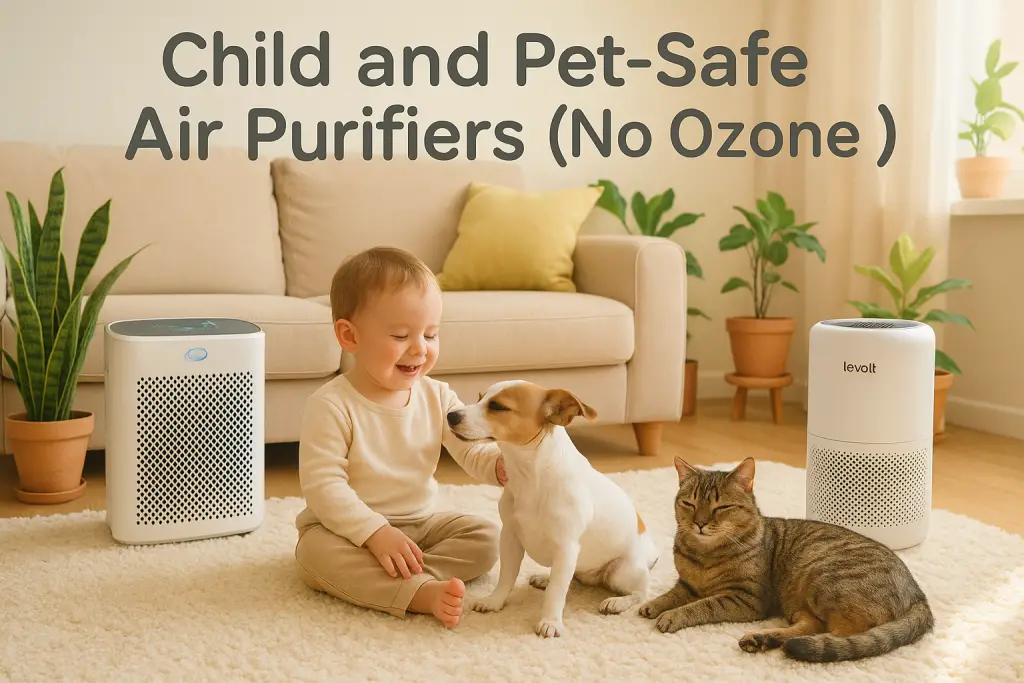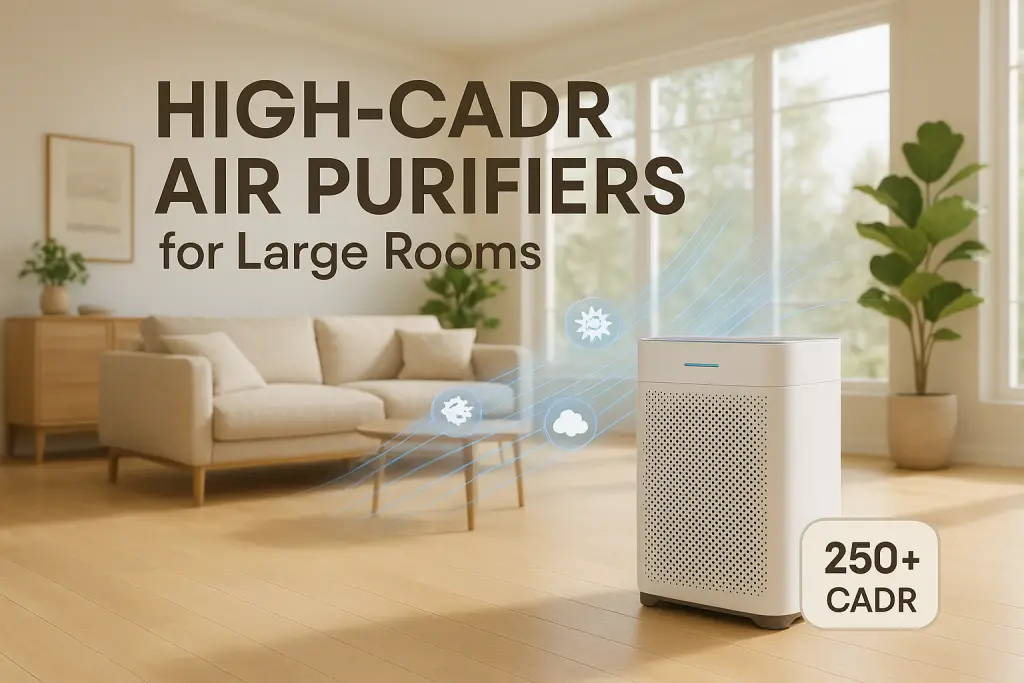Placing your air purifier in the right spot significantly impacts its effectiveness. The ideal location depends on your room layout, airflow patterns, and specific air quality concerns. For maximum performance, position your air purifier in central areas where you spend the most time, keeping it at least 3-6 inches away from walls and furniture. This guide covers everything you need to know about optimal air purifier placement to ensure you’re breathing the cleanest air possible in every room of your home.
How Air Purifiers Work and Why Placement Matters
To understand optimal air purifier placement, you first need to grasp how these devices actually clean your air and the science behind air circulation in your home.
Air purifiers operate through a simple process: they pull in contaminated air, pass it through filters that trap pollutants, and release clean air back into the room. This creates a continuous circulation pattern that gradually improves overall air quality. The effectiveness of this process depends heavily on where you place the unit.
When positioned correctly, an air purifier can clean air efficiently throughout a room. When placed poorly, its performance can drop by 30-50% according to air quality testing. This happens because obstacles block airflow, corners trap air currents, and improper height affects the purifier’s ability to capture airborne particles.
The Clean Air Delivery Rate (CADR) listed on your purifier indicates how much air it can clean per hour, but this rating assumes optimal placement. Poor positioning can negate the benefits of even the most powerful units, especially in open floor plans where air circulation patterns are more complex.
5 Universal Air Purifier Placement Principles for Any Room
Before diving into room-specific recommendations, these five fundamental placement principles will help you maximize your air purifier’s effectiveness anywhere in your home.
1. Keep distance from walls and obstacles
Place your air purifier at least 3-6 inches away from walls, furniture, and other obstacles. This space allows for proper air intake and prevents the unit from working harder than necessary. Air needs room to circulate around the purifier for optimal filtration.
2. Consider elevation options
Floor placement works well for capturing dust, pet dander, and heavier particles that settle low. Table placement (3-5 feet high) helps target airborne allergens and can improve distribution of clean air. Match your elevation choice to your primary air quality concerns.
3. Position near pollution sources
Place your purifier near common contamination sources like kitchen cooking areas, pet beds, or areas with incense smoke that needs filtering. This intercepts pollutants before they spread throughout the room, making the purification process more efficient.
4. Optimize airflow pathways
Never block the intake or output vents of your purifier. Check the user manual to identify these areas and ensure they remain unobstructed. Position the unit so that clean air blows into the center of the room rather than against a wall or furniture.
5. Use central placement when possible
Central room placement typically provides 20-30% better coverage than corner placement. If central placement isn’t practical, position the purifier where airflow naturally moves through the room, such as near doorways or hallway entrances.
Bedroom Air Purifier Placement: Optimizing for Sleep and Overnight Air Quality
Since you spend about a third of your life in your bedroom, optimizing air purifier placement here is crucial for both sleep quality and health.
The ideal placement in bedrooms is 3-6 feet from your bed, positioned so the clean air output blows in your direction. This creates a zone of cleaner air around your sleeping area without blowing directly on you, which could cause discomfort or dryness.
For bedrooms with limited space, consider these options:
- Place the purifier on a nightstand or dresser that’s at least 3 feet high
- Position at least 3 inches from the wall and away from curtains
- Keep the unit 2-3 feet from your head to balance air quality with noise considerations
If you have allergies or asthma that affect your sleep, placement becomes even more critical. Position the purifier between your bed and common allergen sources like windows (pollen), closets (dust), or pet sleeping areas. This creates a protective barrier that filters these particles before they reach you.
For light sleepers, look for purifiers with night modes and place them farther from the bed (4-6 feet) to minimize noise disturbance while still maintaining effectiveness.
Living Room Air Purifier Placement: Balancing Effectiveness and Aesthetics
Living rooms present unique air purifier placement challenges due to their size, multiple furniture arrangements, and their role as social spaces where aesthetics matter.
For most living rooms, place your purifier in the area where people gather most often. This is typically near seating arrangements but not hidden behind furniture. Keep the unit at least 3 feet from sofas and chairs to ensure proper airflow.
In open concept living spaces, position the purifier at the edge of the living area that borders other spaces (like kitchens or dining areas). This helps create a barrier that prevents contaminants from flowing between spaces.
For aesthetic considerations:
- Use console tables to elevate purifiers to the optimal 3-5 foot height range
- Position units beside rather than in front of decorative elements
- Consider the direction of airflow in relation to room layout
Larger living rooms may exceed the coverage capacity of a single purifier. For rooms over 300 square feet, either use a higher-capacity model or consider a multiple-purifier strategy with units placed on opposite sides of the space.
Homes with fireplaces should position purifiers on the opposite side of the room from the fireplace, creating a counterflow that helps capture particulates before they spread throughout the home.
Kitchen Air Purifier Placement: Targeting Cooking Pollutants and Food Odors
Kitchens generate some of the highest levels of indoor pollutants, making strategic air purifier placement especially important in this space.
Position your kitchen air purifier 4-6 feet away from cooking surfaces to avoid heat damage while still capturing cooking fumes. The ideal spot is often on a counter opposite the stove or on a nearby surface at a similar height to where cooking occurs.
Tests show that proper kitchen placement can reduce cooking-related particulate matter by up to 80% and VOCs by 60%. This significantly improves air quality during and after meal preparation.
Important kitchen placement considerations include:
- Keep purifiers away from direct water splashes and high humidity areas
- Avoid placement directly next to the refrigerator, which can create competing air currents
- For small kitchens, place the unit in the doorway facing into the kitchen
- Position at least 3 feet from microwave ovens to avoid electronic interference
In open kitchens that flow into living or dining areas, place the purifier at the boundary between spaces. This creates a filtration zone that prevents cooking pollutants from spreading to adjacent areas.
Air Purifier Placement for Other Rooms: Home Office, Basement, Bathroom, and More
Beyond the main living areas, strategic air purifier placement in these additional spaces can address specific air quality concerns throughout your home.
Home Office Placement
Position your air purifier 3-4 feet from your desk, preferably between you and the door. This location helps filter incoming pollutants and creates a clean air zone in your immediate workspace. For offices with printers or other equipment, place the purifier between these devices and your seating area to capture potential VOCs and particulates.
Basement and Lower-Level Placement
Basements often have higher humidity, mold risks, and limited air circulation. Place purifiers in central locations but elevated at least 2 feet off the floor. Position units near problem areas like laundry equipment or storage zones where moisture tends to accumulate. For finished basements, follow the same guidelines as living rooms while prioritizing areas with limited natural ventilation.
Bathroom Placement
Bathroom placement requires special attention to safety and humidity concerns. Position your purifier at least 4 feet from showers or tubs to avoid direct moisture exposure. Place on countertops or shelves above toilet level, focusing on capturing odors and moisture. Always check that your model is appropriate for high-humidity environments.
Children’s Room Placement
In children’s rooms, safety comes first. Place purifiers where they can’t be tipped over, ideally on surfaces higher than the child can reach. Keep cords secured and units at least 3 feet from beds. Position away from play areas while still maintaining central room coverage. Units with child locks are recommended.
Hallway and Transitional Space Placement
Hallways serve as air circulation highways in your home. Strategic purifier placement in these areas can help filter air as it moves between rooms. Position units at hallway intersections or near stairwells where air naturally flows. This approach works well in homes where room-by-room placement isn’t practical.
Special Placement Considerations for Unique Living Situations
Not every home follows a standard layout. Here’s how to adapt air purifier placement for specific living situations and constraints.
Small Apartments and Studio Spaces
In compact living spaces, every square foot counts. Place your air purifier in the area between sleeping and living zones to benefit both. Elevate the unit when possible to improve air circulation in cramped quarters. For truly limited spaces, prioritize nighttime placement near your bed, then move the unit to living areas during the day.
Multi-Story Homes
Air quality can vary significantly between floors. Place purifiers at the top of stairwells to capture rising pollutants or at the bottom to clean air as it circulates downward. For homes with central HVAC, position units near return vents to help distribute filtered air throughout the system.
Open Floor Plans
Open concept homes present coverage challenges. Position your primary purifier in the center of the open space, with secondary units at transition points between functional areas. This creates overlapping zones of clean air. Aim for elevated placement (3-5 feet high) to improve circulation across the open space.
Homes with Pets
Pet owners should place purifiers near pet beds, litter boxes, or other areas where animals spend significant time. This targeted approach captures dander and odors at their source. Elevation is important, as pet hair and dander can quickly clog filters placed directly on the floor.
Rental Restrictions
Shared apartments and rental properties often come with placement limitations. When wall placement isn’t allowed, use furniture to create optimal positioning without attachments. Focus on portable, freestanding units that can be positioned effectively without modifications to the property.
Seasonal and Situational Air Purifier Placement Adjustments
Your air purifier placement shouldn’t remain static year-round. Here’s how to adjust placement seasonally for maximum effectiveness.
Winter Placement Strategies
During winter, homes are typically sealed tight with heating systems running constantly. Place purifiers near heating vents or radiators (but not blocking them) to help clean recirculated air. Keep units away from fireplaces and at least 6 feet from space heaters. Position closer to exterior doors to capture pollutants that enter when people come and go.
Summer Placement Considerations
Summer brings open windows and different air patterns. Place purifiers between windows and the rest of the room to filter incoming air before it circulates. In rooms with air conditioning, position units away from direct AC airflow while still maintaining central placement. For homes without AC, place purifiers in rooms where people gather during hot days.
Allergy Season Adjustments
During high pollen seasons, prioritize purifier placement near windows and entryways, even if they’re closed, as these are common infiltration points. For allergy sufferers, bedroom placement becomes even more critical during peak seasons. Consider a secondary unit specifically for entryway areas where outdoor allergens first enter the home.
Wildfire Season Placement
When outdoor air quality deteriorates due to wildfires, create a clean air room by focusing your most powerful purifier in a single, smaller space where family members can gather. Close all windows and doors, using door towels if needed to prevent smoke infiltration. Position units away from windows but centrally in the designated clean room.
Special Events
For gatherings or events, temporarily reposition purifiers to social areas. Place units at the edges of gathered groups, positioned to pull air from the crowd and release clean air back toward them. For renovations or construction, create containment zones with purifiers at the boundaries to prevent dust and particulates from spreading.
How to Verify Your Air Purifier Placement is Working Effectively
How do you know if your air purifier placement is actually working? These verification methods will help you test and optimize your setup.
The simplest test is the dust test: Clean surfaces in the room, then check dust accumulation patterns after 3-7 days. Areas near effective purifiers should show significantly less dust buildup. You can also perform a basic airflow test using a tissue held 12 inches from the purifier output – it should move noticeably in the direction of airflow.
For more precise measurement, consider using an air quality monitor. These devices track particulate matter, VOCs, and other pollutants in real time. Take baseline readings before placing your purifier, then check again after 24-48 hours of operation. Effective placement should show at least a 50% reduction in particulate matter.
Signs your placement may not be working include:
- Little to no improvement in allergy symptoms
- Filters that remain relatively clean even after weeks of use
- Persistent odors or visible dust in the air
- Uneven air quality in different parts of the room
If your current placement isn’t showing results, try repositioning using the principles outlined earlier and test again after 48 hours.
9 Common Air Purifier Placement Mistakes to Avoid
Even with the best intentions, these common placement mistakes can significantly reduce your air purifier’s effectiveness. Here’s how to identify and fix them.
1. Placing in corners or against walls
This restricts airflow by up to 50%. Fix: Move the purifier at least 3-6 inches from any wall and position it toward the center of the room whenever possible.
2. Blocking airflow with furniture or curtains
Objects near intake or output vents force the purifier to work harder for less result. Fix: Create a clear zone around all sides of the purifier, especially the intake and output areas.
3. Placing too high or too low
Extreme heights limit circulation patterns. Fix: Position most purifiers between 2-5 feet from the floor for optimal air movement.
4. Ignoring manufacturer’s specific placement guidelines
Different models have different airflow designs. Fix: Always check your user manual for model-specific placement recommendations.
5. Placing near electronics or interference sources
TVs, speakers, and microwaves can interfere with purifier sensors. Fix: Keep purifiers at least 3 feet from other electronic devices.
6. Positioning in drafty areas
Strong air currents from windows, fans, or vents disrupt purifier effectiveness. Fix: Position away from direct drafts while still maintaining good room coverage.
7. Overlooking multiple pollution sources
Focusing only on one source leaves others unaddressed. Fix: Map all pollution sources in your room and position to address the most critical ones first.
8. Neglecting to adjust placement seasonally
Static positioning ignores changing air quality threats. Fix: Reassess placement quarterly as seasonal factors change.
9. Using a purifier that’s incorrectly sized for the space
No placement can compensate for an undersized unit. Fix: Ensure your purifier’s CADR rating matches your room size, or use multiple units for larger spaces.
Multiple Air Purifier Strategies for Whole-Home Purification
For larger homes or those with significant air quality challenges, a single air purifier may not be sufficient. Here’s how to implement an effective multi-purifier strategy.
Start by identifying priority zones: typically bedrooms, main living areas, and specific problem areas like kitchens or home offices. Place your most powerful purifier in the room where you spend the most waking hours, with secondary units in bedrooms and other frequently used spaces.
For two-story homes, place at least one unit on each level, positioning them near stairwells or central hallways to maximize air circulation between floors. Studies show that strategic placement of multiple smaller units often outperforms a single large unit, improving whole-home air quality by up to 30% more effectively.
Consider different purifier types for different rooms based on specific concerns:
- HEPA units for bedrooms and living areas
- Activated carbon filters for kitchens and areas with odor concerns
- Ozone-free purifiers for spaces where chemical sensitivity is a concern
For homes with central HVAC, position portable purifiers to complement rather than compete with airflow patterns. This hybrid approach can improve whole-home air quality more effectively than either system alone.
Air Purifier Placement FAQ: Expert Answers to Common Questions
Here are expert answers to the most frequently asked questions about where should I place the purifier for best results to address your specific concerns.
Q: How far should an air purifier be from the wall?
A: Keep your air purifier at least 3-6 inches from any wall to allow proper air intake. Units placed flush against walls can have their efficiency reduced by up to 40%.
Q: Can I put my air purifier on the floor?
A: Floor placement works well for capturing dust and pet dander but isn’t ideal for general air circulation. If using floor placement, elevate the unit 4-6 inches on a stable platform when possible.
Q: Should I put air purifier near window?
A: Place purifiers 6-10 feet from open windows to help filter incoming air without being overwhelmed by direct outdoor airflow. For closed windows, 3-4 feet away is sufficient to catch any infiltration.
Q: Where should air purifier be placed in bedroom?
A: Position bedroom purifiers 3-6 feet from your bed, preferably between your sleeping area and doors or windows. This creates a zone of clean air around your breathing space all night.
Q: How long should you run an air purifier?
A: Most air quality experts recommend running purifiers 24/7, especially in bedrooms and high-traffic areas. If continuous operation isn’t possible, run the unit at least 4 hours before occupying the space.
Q: Should air purifier run all day?
A: Yes, continuous operation maintains consistent air quality. Modern purifiers are designed for constant use, and many automatically adjust fan speeds to conserve energy when air quality is good.
Q: Can I move my air purifier from room to room?
A: Yes, portable purifiers can be moved, but allow 30-60 minutes in each new location to establish effective air circulation. For homes with multiple air quality concerns, dedicated purifiers for each main room are more effective than relying on a single unit.
Q: Should I place my air purifier near my plants?
A: Keep purifiers at least 4 feet from houseplants. While plants naturally improve air quality, debris from soil and leaves can quickly clog filters if placed too close.
Conclusion: Creating Your Personalized Air Purifier Placement Plan
Now that you understand the principles of effective air purifier placement, it’s time to create a personalized strategy for your specific home and needs.
Start by mapping your home’s layout and identifying your primary air quality concerns in each space. Prioritize placement in rooms where you spend the most time, particularly bedrooms and main living areas. Remember the core principles: central positioning, proper distance from walls and obstacles, appropriate height, and proximity to pollution sources.
Be prepared to adjust your placement seasonally and as your needs change. What works well in winter may need modification during allergy season or when wildfire smoke threatens. Test your placement effectiveness regularly using the methods described earlier.
The most effective air purification comes from thoughtful placement rather than simply purchasing the most powerful unit. By applying these expert placement strategies, you can significantly improve your indoor air quality and create a healthier living environment throughout your home.
| Photo | Air Purifier Model | Best for | Price |
|---|---|---|---|

|
WINIX A231 Air Purifier | Asthma & Indoor Pollution | Check Price On Amazon |

|
Rabbit Air, A3 SPA-1000N Air Purifier | Pet Dander & Odors | Check Price On Amazon |

|
LEVOIT Air Purifier | Best Overall | Check Price On Amazon |

|
GermGuardian Air Purifier | Cigarette & Cooking Smoke | Check Price On Amazon |

|
Coway Airmega Air Purifier | New-borns | Check Price On Amazon |

|
BLUEAIR Air Purifier | Germ & Virus Control | Check Price On Amazon |
